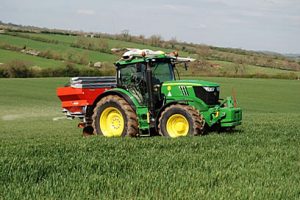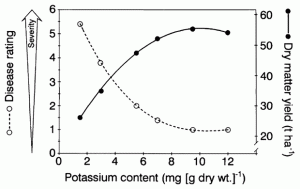Download pdf: The role of potash in plants (167.08K)
pdf 167.08K
The role of potash in plants
May 2015
Ian Matts, Company Agronomist, Yara UK
Potassium is one of the major nutrients required by all crops and is present in large quantities in the plant in the form of the cation K+. It plays a major role in achieving the maximum economic yield, as part of a balanced approach to crop nutrition, as well as influencing crop quality.
Potassium is fundamental to many metabolic processes through the activation of a large number of enzymes required for chemical reactions. These include the synthesis of proteins and sugars required for plant growth. Only a relatively small proportion of the plant’s total potassium requirement is needed for this. The majority is required for the essential role of maintaining the water content of plant cells. These roles are discussed below. Many are interlinked.
Protein Synthesis and Nitrogen Utilisation
 Protein synthesis is the production of proteins required for plant growth. Nitrogen is another nutrient that is also required by plants for protein synthesis and, where potassium levels in the plant are low, protein synthesis can be reduced, despite an abundance of available nitrogen. Potassium helps improve both the uptake of nitrogen from the soil, and the conversion of nitrogen in the plant to amino acids and ultimately protein. Maintaining adequate potassium levels is therefore very important for maximising the use of nitrogen within the plant.
Protein synthesis is the production of proteins required for plant growth. Nitrogen is another nutrient that is also required by plants for protein synthesis and, where potassium levels in the plant are low, protein synthesis can be reduced, despite an abundance of available nitrogen. Potassium helps improve both the uptake of nitrogen from the soil, and the conversion of nitrogen in the plant to amino acids and ultimately protein. Maintaining adequate potassium levels is therefore very important for maximising the use of nitrogen within the plant.
As with nitrogen, potassium is taken up in large quantities by most crops during the rapid growth phases in spring and early summer, with peak uptake reaching up to 10kg/ha/day.
Turgor Pressure and Lodging Resistance
Potassium is an important nutrient for helping plants resist lodging. This is achieved through its influence on osmosis and turgor pressure, and by cell wall construction.
The process of osmosis is responsible for the movement of water within the plant and also the uptake of water from the soil by roots. This movement of water occurs as a result of the differences in the concentration of salts within the plant cells, which is largely a function of potassium as the K+ cation.
Turgor pressure is caused by the osmotic flow of water into cells causing them to swell, putting pressure on the cell walls to help maintain a rigid and upright structure for plants.
Potassium is also involved in the synthesis of cellulose, a component of cell walls. An adequate supply of potassium is therefore required for increasing the thickness and strength of cell walls, hence reducing the likelihood of lodging.
Water balance and Drought Tolerance
Plants also rely on potassium to regulate the opening and closing of the stomata. These are the tiny apertures on leaves, mainly found on the underside, surrounded by guard cells which control their opening and closing. The stomata are important for allowing the movement of carbon dioxide into the plant, as well as the release of oxygen and the loss of water vapour. The plant regulates the opening and closing of the stomata through the movement of potassium into or out of the guard cells.
When water supply is short, the cells close the stomata to prevent water loss to the atmosphere. If potassium levels within the plant are low the stomata become slow to respond and they do not close as quickly, resulting in the wasteful loss of water vapour. As a result, plants with an insufficient potassium supply are more susceptible to drought.
Frost Tolerance
Potassium promotes a high concentration of sugars in cells. This increase in sugar content in cells helps to lower the sap’s freezing point, acting as antifreeze agents, and resulting in improved frost tolerance. This is particularly helpful for potatoes.
Photosynthesis
The effect of turgor pressure in cells has a knock on impact on photosynthesis. This is the critical process for plants to convert energy from the sun into chemical energy, in the form of sugars, required for growth and ultimately yield. These sugars contain carbon derived from carbon dioxide from the atmosphere that enters the plant through the stomata. So, the role of potassium in the regulation of stomatal opening is also important for efficient photosynthesis by controlling the movement of carbon dioxide into the leaf. Low levels of potassium can result in inefficient stomatal activity, reducing the level of photosynthesis.
Turgid, swollen cells also have a larger surface area which increases their photosynthesis. Drought stressed leaves tend to roll, reducing the surface area, and reducing photosynthesis.
Potassium also has an impact on the production of ATP, the plant’s energy source. When plants are deficient in potassium the rate of photosynthesis is reduced and hence the rate of ATP production is also reduced.
Transport of water sugars and nutrients
Osmosis is needed in plants, not just for effective water movement round the plant in the xylem, but also for the transport of sugars and proteins required for growth. This is of particular importance late in the plants life for building high yields.
These sugars are produced by photosynthesis in the leaves, but are required in the grains, roots or tubers of the plant. They are transported around the plants in the phloem, and require energy in the form of ATP. When plants are low in potassium, less ATP is available and the transport system slows down. This causes photosynthates to accumulate in the leaves and so the rate of photosynthesis reduces.
Disease and Pest Resistance
Potassium has an essential role in plant disease and pest resistance, probably the most effective of all the nutrients. It is a regulator of enzyme activity, and therefore involved in nearly all cellular functions that influence disease severity.
As already mentioned, potassium is required for the synthesis of proteins, starch and cellulose. The function of cellulose on cell wall thickness not only impacts on the plant’s standing power, but also acts as a mechanical barrier to invasion and infection. Potassium deficiency reduces cellulose production, leading to thinner cell walls with less resistance to infection.

As a rule, susceptibility to disease decreases in response to potassium in the same way that the growth of a plant responds to increasing potassium supply (as shown in the graph). Beyond optimal supply for growth, there are no further benefits from additional potassium in terms of plant health. So if the soil supply is adequate for growth (index 2-) then the supply for defence against diseases and pests is adequate.
Recent analytical results from Lancrop Laboratories have shown 87% of wheat crops and 85% of oilseed rape crops being below the guideline tissue levels in the Spring, and nearly a third of UK soils, over the last few years, have been below the target index (2-). The level of potassium deficiency may not have been enough to show any visible symptoms of disease or the effect of pests, but it could be leading to an increase in susceptibility of the plants, and putting more strain on the other methods of control.
Potassium uptake is greatest during the period of most rapid growth as plants reach the stem extension stage. Applications of potassium early in the Spring, help supplement the supply from the soil, whether it is at or below target level. Foliar applications can help to target a small quantity of potassium directly to the plants, however this cannot be relied on where the level of deficiency is too great.
Just as humans produce antibodies after infection, plants also have a similar defence mechanism when infected by a pathogen. The infection causes increased production of certain chemicals that form part of the plant’s defence mechanism. The potassium status of a plant is important for both the production and the transport of these compounds to the site of infection. Shortages reduce the amount of natural antifungal compounds, increasing the plant’s susceptibility to disease, once it has penetrated the cells.
Conclusion
Potassium is an essential nutrient for crop growth, being fundamental to many plant processes that impact on crop yield, quality and plant health. It is required in very large quantities, with peak potash uptake in cereals reaching more than 250kg/ha by the end of flowering. The importance of balanced nutrition is clearly evident with potassium, due to its close interactions with nitrogen, both in uptake through the roots and utilisation within the plant. A shortage of potash will not only result in lower nitrogen use efficiency, but will also lead to greater drought susceptibility, increased lodging, a reduction in photosynthesis and restricted movement of water, nutrients and sugars around the plant.

